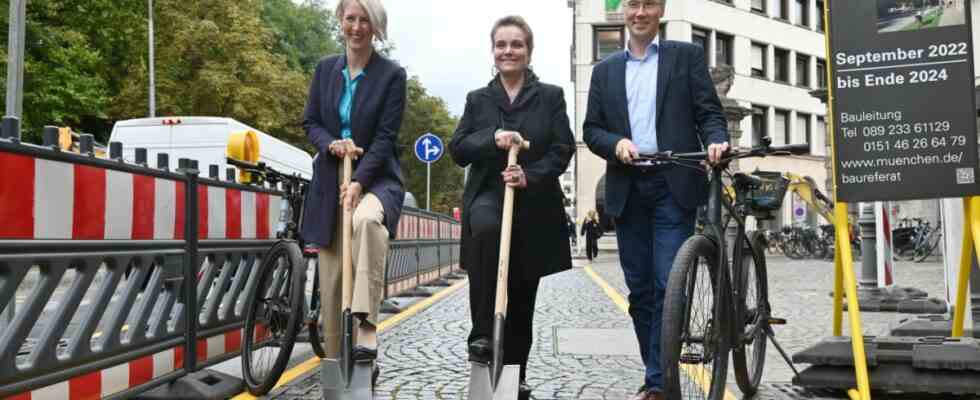It was one of the first appointments for the new construction officer Jeanne-Marie Ehbauer. And then one where a – as she says – “lighthouse” is built. The lighthouse project is the first small section of the new express cycle path in the direction of Garching, for the construction of which the city officially gave the go-ahead on Friday, although the construction work is actually already underway. It is the very first cycle expressway in Bavaria. At 500 meters between Lenbachplatz and the square of the victims of National Socialism, a 2.80 meter wide cycle path is created in each direction, which is also a section of the old town cycle ring. A total of 93 parking spaces will be lost in the Maximiliansplatz area. Two lanes will remain for cars.
First of all, the street in the direction of the Place of Victims of National Socialism will be reconstructed. According to the building department, this will last until 2024. Then work will begin on the section towards Lenbachplatz. On the old town side, a parking bay for buses will be created instead of the car parking spaces. On the opposite side, facing Maxvorstadt, the plan provides for taxi parking spaces. The former car parks directly adjacent to Maximiliansplatz will be unsealed on both sides of the park and planted with trees. The intersection of Maximiliansplatz/Oskar-von-Miller-Ring and Brienner Straße will be converted into a four-arm node in 2023. This creates a small closed green area, which is currently called “Platanenplatz” because of the trees there.
The cycle expressway in the Munich city area will be 9.1 kilometers long in total. It leads via Ludwigstrasse and Leopoldstrasse and further along Ingolstädter Strasse to the city limits. Where possible, the wheel lanes should have a standard width of three meters. The complete route to Garching should then be 23 kilometers long. The costs alone for the conversion of the section that has now begun are 13.4 million euros. The federal government will pay 2.4 million.
At the start of construction, representatives of the building department, the mobility department and the Bavarian Ministry for Housing, Construction and Transport as well as from Munich city politics gathered in front of the Maxtor. Mayor Katrin Habenschaden (Greens) explained that cycle highways are the best instrument for getting commuters to cycle. “Expressways are the arteries of every cycle path network,” said habenschaden. The new Radschnellweg will be something like a motorway, but just for cyclists. She was optimistic, said habenharm, but that things weren’t as “rowdy” there as on the real autobahns.
When cyclists will be able to commute really quickly between Garching and Munich city center is still completely open. Because the process drags on. In the district of Munich, for example, the route has been tinkered with for six years. There the cycle expressway should lead from the city limits to the cities of Unterschleißheim and Garching. But not a single meter of the Radl-Highway has been built, the construction costs of which are estimated at more than 35 million euros in the district alone.
In particular, the planning for the section in the university town of Garching caused problems for a long time. The plan to route the cycle expressway along federal highway 471, one of the busiest roads in the north of the state capital, repeatedly met with resistance in Garching – the city and district have now agreed on a route that runs a little further south along the Schleißheim Canal and from there to the north in order to open up the campus there with the TU facilities.
It is not yet clear when the construction work on the cycle expressway in the district will begin. It was actually planned to start with the first preparatory work this year, but it will probably not be possible to keep to the schedule. And the question of financing will probably continue to cause headaches for district politicians. If the Greens in the district council have their way, if cycle highways are to be elevated to the status of federal roads, then the federal government would actually be responsible for the construction and maintenance of the connections.

